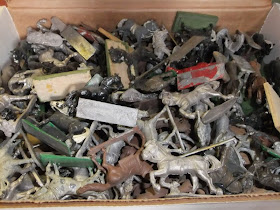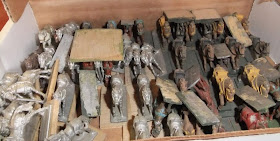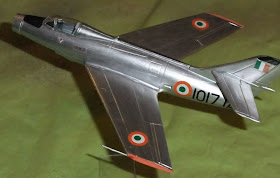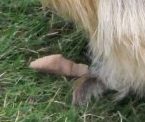Well, a plan anyway. Now that I have sorted out and (up to a point) identified all of the the figures retrieved from JR's attic, I have come up with a plan to actually use them!
Most of the figures are what we wargamers call 'ancients', so chronologically this seems like a good place to start! The mostly unpainted figures can be summarised as follows:
Assyrian Infantry
Macedonian/Successor types - enough for a sizable army
Roman cavalry and a load of artillerymen
Sassanid infantry
Cataphract cavalry (& camels!)
My plan is to repair the painted chaps first and then paint some of the others, plugging the gaps between random units and fieldable armies with plastic figures. Martin very kindly brought along some of his plastic (mostly HAT) figures last week to conduct size comparisons and the old 'proper' 25s are a good match for modern plastics. An order has been placed....
The 'Ancient' period games I play currently are Strategos/Lost Battles and Command & Colours (S and CCA hereafter), the latter on Hexon hexes (which are 10cm across). I am also having a look at Impetus.
As to base sizes, it would indeed be nice to be able to fight battles with friends' armies, and negotiations have been conducted with fellow classic 25mm enthusiasts Ian D and John B. While Martin's plastics are on 'WRG' sized bases (6cm frontage), and that seems in many ways the obvious thing to do, I won't. For the following reasons:
1. Most of my 6mm ancients are on WRG types bases (4cm frontage) and actually look pretty good (16 close order infantry, 4-8 cavalry etc), but a couple of ebay 'accidents' last year saw the acquisition of some figures on much larger bases, too nice to be re-based. All have been successfully used in games, helped by the fact that both S & CCA use forms of area movement, so as long as there is a way of recording casualties - either by removing smaller bases or placing hit markers ('Where the plastic crosses grow...') on the larger ones.
My experiments with bases for the 25s have led me in the direction of the 8cm frontage, with depths of 3-4 cm for infantry and 5-6 cm for mounted troops. My rationale is as follows:
2. I don't like removing part units during a game - it is messy, increases wear and tear on the toys and casualties are easily marked (I use tile spacers).
3. The bases will look more like units than small clumps of toy soldiers. Close order infantry can be based on two ranks - 8-10 or so to a base, lights maybe 3-4 to a base and somewhere in between for loose order peltasts and hairy warbands (that's Light Medium Infantry for those of us who came in with WRG 5th Edition....). Cavalry bases will have two lights or four heavies, leaving those who aren't quite sure with three figures. Perversely, I will probably mount elephants singly on narrower bases...
4. 8cm fits neatly into the 10cm Hexon hexes in which I have a considerable investment.
5. A decent sized force could be fielded on my 180x90cm wargames table.
6. 8cm is visually compatible with multiples of John B's 4cm bases.
7. 8cm is big enough - looking 'ahead' to the 17thC - to mount combined pike & shot units.
8. MDF bases in the sizes mentioned will be stable enough for metal toys and give the plastics enough stability.
I commend this base size to the house!
Coming soon - I actually base some figures.


















































